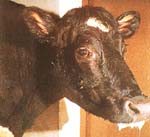Late in the day on December 23, 2003 the U.S. government
announced that a dairy cow in Washington state was infected with mad cow
disease, also called bovine spongiform encephalopathy (BSE). Government
officials announced that they have a plan, but it seems to be a public
relations plan, not a plan to protect the public health. Newspapers report
that meat from the cow, who was killed December 9, traveled through three
processing plants before the problem was discovered 13 days later.
What Is Mad Cow Disease?
Spongy brains, whether in humans, cows, or other animals, are caused by
malformed proteins called prions. Researchers have traced recent outbreaks of
the bovine version of the disease to farmers’ cost-cutting practice of
mixing bits of dead sheep’s neural tissue into the feed of cows, who are
naturally herbivorous. If cows eat the brains of other cows who already have
BSE or of sheep suffering from a sheep disease called scrapie, the animals can
develop mad cow disease. When people eat infected animals, thus far presumed
to be cows, they could develop the human version of the disease, new variant
Creutzfeldt-Jakob disease (nvCJD). Millions of cattle suspected of being
infected with BSE in England, Scotland, Ireland, France, Belgium, Italy, and
other countries have been incinerated, and various safeguards (few of which
have been adopted in the U.S.) have been instituted.

No matter what species it strikes, spongiform encephalopathy is always fatal.
There is no treatment. The disease eats holes in the brain. In humans, it
initially causes memory loss and erratic behavior, and over a period of
months, its victims gradually lose all ability to care for themselves or
communicate, and eventually, they die. So far, more than 120 people in Europe
have died from nvCJD.
Because the infected cow was raised for dairy production, she had lived
long enough to show symptoms of the disease. Most cows are killed before they
turn 2 years old, chickens at 6 to 7 weeks, and pigs and turkeys before
they’re 6 months old, long before they could become symptomatic; no one
would know whether they were infected with spongy brain disease, and the U.S.
Department of Agriculture (USDA) is doing nothing at all to try to find out.
In fact, the USDA admits that it only tested about 20,000 cows (and no other
animals) for BSE last year—a statistically insignificant percentage of the
approximately 40 million cows and 10 billion other animals slaughtered
annually.
The dangerous practice of feeding sheep and even cows to other cows was not
banned in the U.S. and Canada until 1997, and the U.S. government said that as
recently as 2001, there was widespread violation of the feeding regulation. It
is still legal to feed cow’s blood to cows, to feed sheep and cows to pigs
and chickens, and to feed pigs and chickens to one another and to cows, even
though these practices have been banned in Europe. In fact, European countries
have instituted an array of safety precautions, which have not yet been
adopted in the U.S., to try to protect their populations from spongy brain
diseases.
Other forms of spongy brain diseases have been found in North America. In May,
an 8-year-old cow on a dairy farm in Alberta, Canada, was found to have BSE.
Two years ago, 200 sheep raised for dairy on a Vermont farm were killed on
suspicion that they were infected with their species’ equivalent of mad cow
disease. Chronic wasting disease, a similar condition, is widespread in deer
and elk in Western Canada and the U.S. and is suspected of infecting hunters
who may have eaten meat from sick animals.
Can You Protect Yourself?
Yes! The best way to protect yourself and your family is to
stop eating animal products and choose a companionate vegan diet. A vegan diet
not only protects you from mad cow disease, but is the most effective way to
prevent foodborne illness, heart disease, strokes, and many other ailments.
If you eat meat, you already have to worry about salmonella, E. coli,
campylobacter, heart disease, strokes, high blood pressure, and cancer, as
well as your weight. Now, add mad cow, chicken, fish, pig, and turkey disease
to the list— if there's a brain, it could have a spongy brain (spongiform
encephalopathy); we've already identified mad cow disease variants in humans,
sheep, mink, cows, elk, deer, and cats.
